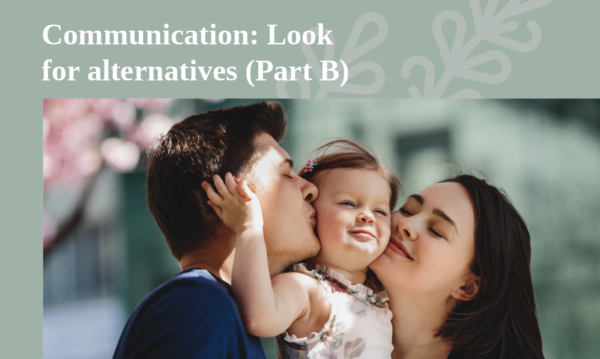Search for alternatives
There are cases where children need help to think about various possible ways in which they can act. Sensitized parents can help them search for alternatives and choose the solutions that suit them.
By helping your child consider alternatives, you are essentially helping them clarify and think about possible options for solving the problem and evaluate each way of implementing them.
The steps you will take when searching for alternatives are the following:
1. Use reflex hearing to understand the child’s feelings. (“You’re angry…”, “It seems to me that you feel…”)
2. Seek alternatives by using your child’s resourcefulness and imagination. (“Do you want to look at some things you could do?”, “If you’re interested in doing better at school, what could you do?”) Get as many ideas as possible from the child.
3. Help the child choose a solution and evaluate the various possibilities. (“Which idea you think is the best?”)
4. Discuss the possible effects of his decision. (“What do you think will happen if you do that?”)
5. Ask the child for a commitment. (“What did you decide to do?” “When are you going to do that?”)
6. Schedule a date for evaluation. (“How long will this action last?” “When are we going to talk about it again?”)
There may be cases where the child cannot find satisfactory solutions because he does not have the appropriate experience. In these cases, make your suggestions in a questioning way: “What do you think could happen if you…”
Limit your suggestions as much as possible so that the child is more independent to solve his problems. It is crucial to choose the right time as there must be meaningful communication so that your intervention to seek alternatives works effectively.
Whose problem is it?
The techniques of reflective listening and the search for alternatives are beneficial when the problem mainly concerns the child. In the following examples, you can clarify who is affected primarily by the issue:
1. The child is prevented from meeting his or her need (e.g., he or she fought with a classmate and is distressed). The problem does not affect the parent but concerns only the child.
2. The child meets his own needs, is not hindered by anyone, and his behavior does not hinder the parents; therefore, there is no problem in the parent-child relationship.
3. The child meets his own needs and does not encounter any obstacles. However, his behavior creates a problem for parents because he intervenes in their lives and needs (e.g., the child watches TV at a high volume and does not let the parents sleep). Now the parents have the problem.
After you determine who has the problem, you can try to solve it. If the problem affects your child exclusively, you can either actively search for and suggest ways to deal with the problem or let the child first deal with the consequences of the situation on its own. If it’s necessary, you will intervene later to help the child. If the problem concerns you, there are several ways to deal with it, which we will look at below.
Messages to the First-Person (I…)
When you talk to your children, it is beneficial to think about how the child perceives your messages to the second person (You…) and how to the first person (I…)
The message expressed in the second person (You…) usually blames and criticizes the child. It implies that it is to blame; it is a verbal attack.
Instead, the message to the first person (I…) describes how you feel about the child’s behavior. This message is about you, not the child. It informs the child how you feel; it doesn’t blame. The statements in the first person express the feelings that has the person who emits them. Of great importance are the elements that we give on a non-verbal level, such as voice or facial expression. A message to the first person (I…) that we transmit with anger turns into a message to the second person (You…), which shows hostility.
That doesn’t mean we should never be mad at our kids. The difference lies not in anger but the purpose of anger. Our goal may be to control, defeat, or avenge. It’s good to realize how often we use anger. Frequent use of anger can bring the following results:
1. The child’s purpose is reinforced, whether its purpose is superiority or revenge; once you are angry, the child knows that he has succeeded in trying to provoke you.
2. Difficulty communicating. The child feels threatened, defended, or counterattacked.
If the parent-child relationship is based on mutual respect, casual anger can clear the atmosphere and foster communication. But if frequent conflicts characterize the relationship between them, then the use of anger can hurt even more. Suppose your relationship with your children belongs to the second category. In that case, it is a good thing to realize the purpose of your anger and look for alternative ways to defuse it rather than using it as a means of communicating with your children.
How to create a message in the first person (I…)
Before you express your disapproval to the child, consider that it is usually not the child’s behavior that displeases us, but rather the disturbing consequences of the behavior on you. For this reason, it would be useful when you tell children how you feel about their behavior, show them that your feelings (positive or negative) are related to the consequences of their behavior and not to the behavior itself.
Our purpose is to focus on the consequences that this behavior has on us, rather than on the behavior itself. So it is advisable that the messages we express verbally be in the first person (I…). A first-person message is formed and consists of the following three parts:
1. Describe the behavior that disturbs you (describe; do not blame). “When you don’t call me or don’t come home after school…”
2. Express how you feel about the effect this behavior has on you. “… I’m worried something might have happened to you…”
3. Indicate consistency. «… because I don’t know where you are.”
Therefore, a message to the first person usually refers to three elements:
1. Behavior
When you… (describe the behavior)
2. Emotion
I feel… (indicate your feeling)
3. Consistency
Because… (indicate consistency)
If you want to improve your relationship with your child, find the right time for an open and friendly conversation. It’s usually best not to try to talk during a fight. During these times, it is preferable to withdraw from the “battlefield”, maintaining mutual respect. When you show respect during a conflict, you pave the way for an open discussion later.
References:
Dinkmeyer, D., McKay, G., D., (1976). Parent’s Handbook, American Guidance Service, Inc.


